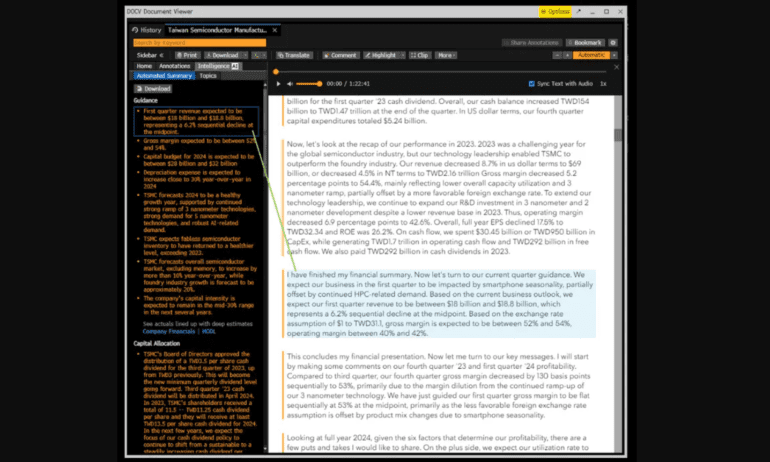TL;DR:
- Bloomberg introduces a groundbreaking AI summarization tool for Terminal users.
- The tool utilizes advanced language models to help analysts decipher complex financial information efficiently.
- Designed to save time by guiding users to key insights within call transcripts.
- It emphasizes eliminating “hallucinations” in financial analysis.
- The system is fine-tuned on contexts related to company financials and earnings.
- Research analysts’ questions inform and enhance the AI’s ability to provide factual details.
- Other financial giants like Goldman Sachs and Morgan Stanley are also exploring AI for similar purposes.
- Bloomberg’s commitment to leveraging AI for better research and client support.
Main AI News:
Quarterly earnings reports, a necessary staple in the world of finance, have often been met with sighs from business journalists and analysts alike. These marathon earnings calls typically yield only a handful of critical insights amid an avalanche of mandatory disclosures and self-congratulatory rhetoric. For years, news agencies and investment research firms have resorted to automated tools in a bid to distill these lengthy calls into concise briefs. However, these summaries often lacked the finesse of human analysis, coming across as robotic and formulaic.
Enter Bloomberg’s game-changing summarization tool, designed exclusively for its Terminal users, poised to elevate the way financial information is deciphered. Powered by cutting-edge large language models (LLMs), this revolutionary system promises to enable users to navigate complex financial data seamlessly and extract key insights that matter most to analysts.
The tool’s primary objective is to streamline the research process for Bloomberg Terminal users, empowering them to save valuable time while delving into extensive call transcripts. This innovative offering made its debut in January, strategically aligning itself with the onset of the 2024 earnings season.
While it’s marketed as a summarizer, Bloomberg’s global head of research for listed core services product, Andrew Skala, sees it as much more than that. He emphasizes the tool’s role in highlighting critical information and directing analysts to the relevant segments of call transcripts, ultimately ensuring that they make informed decisions in the high-stakes world of financial services.
Skala clarified, “We use the term summarization, but I look at it slightly differently. What’s different is we only put the summaries next to the transcripts, and we’re using them as a way for clients to dive deeper into the document themselves.“
This remarkable tool is built upon an undisclosed foundational model, meticulously fine-tuned to contexts closely resembling company financials and earnings. Bloomberg went the extra mile by enlisting its own research analysts to pose questions regarding existing earnings transcripts and provide their own summaries, thus supplying invaluable training data for the system. These questions also serve as a roadmap, guiding the AI toward the pertinent topics.
According to Bloomberg’s head of AI engineering, Anju Kambadur, this approach ensures that the system not only delivers granular details but also remains as factually accurate as possible. He acknowledges that straightforward queries, such as “What was the revenue?” are relatively simple for the AI to handle. However, when faced with more complex inquiries, the system expertly directs readers to the relevant transcript sections.
Kambadur elaborates, “This is why we attribute back because we do our best to say, ‘Guys, this is where the answer is found. This is the key question. Here is our quick read on the answer. But please go look at it yourself.‘”
Bloomberg isn’t the only financial institution recognizing the potential of generative AI in simplifying the analysis of copious amounts of financial data. Industry giants like Goldman Sachs and Morgan Stanley have also dabbled in using AI to summarize intricate financial documents. Bloomberg, in particular, initiated the BloombergGPT research and development project to ascertain the technology’s optimal integration within its business processes.
Kambadur explains, “We did this research project on BloombergGPT. A big motivation for that was to just understand, ‘What is this technology good at? What is it not yet good at?’ And right now where we are comfortable is building exactly the kind of products…where we can ground the answers, provide transparency, use retrieval to boost confidence, both for ourselves and for our clients.”
In terms of future generative AI initiatives, Skala affirms that Bloomberg remains committed to exploring various avenues, all with the overarching goal of assisting clients in saving time and enhancing their research capabilities. He concludes, “Our clients want to do better research and come up with more ideas. And a lot of that is how do we leverage this technology to help them save time to reduce duplication to allow them to differentiate their own research process.”
Conclusion:
Bloomberg’s innovative AI tool represents a significant leap in the world of financial analysis, empowering analysts to extract crucial insights efficiently. This advancement underscores the growing trend of AI integration in the financial market, as other major players follow suit, aiming to enhance research processes and ultimately serve clients better.

